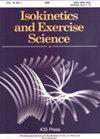Isokinetic testing protocol-based discharge criteria after anterior ligament reconstruction: A systematic review
IF 0.7
4区 医学
Q4 ENGINEERING, BIOMEDICAL
引用次数: 0
Abstract
BACKGROUND: The return to activities and sports after the anterior cruciate ligament (ACL) reconstruction is a critical decision. OBJECTIVE: To verify the most used elements during the isokinetic evaluation for discharge after ACL reconstruction. METHODS: Systematic review (PROSPERO CRD42021224433). Research in the literature: PubMed, Medline, SciELO, Lilacs, CENTRAL, PEDro, Web of Science and Embase, in February 2022. Studies that performed isokinetic evaluation during the discharge period in male patients aged 18 to 59 years after ACL reconstruction. Descriptive synthesis on the most used parameters during isokinetic evaluation as a discharge criteria after ACL reconstruction. RESULT: Twenty-three studies involving 1,792 participants were included. Medium and high quality evidence identified that most isokinetic evaluations targeted only muscle strength after rehabilitation of the ACL (peak moment). CONCLUSION: The most used elements during the isokinetic evaluation were: angular velocity of 60∘/s, 1 set of 5 repetitions, concentric mode and peak moment.前韧带重建后基于等速测试方案的出院标准:系统回顾
背景:前交叉韧带(ACL)重建后恢复活动和运动是一个关键的决定。目的:验证前交叉韧带重建术后出院等速评估中最常用的指标。方法:系统评价(PROSPERO CRD42021224433)。文献研究:PubMed, Medline, SciELO, Lilacs, CENTRAL, PEDro, Web of Science and Embase,截止到2022年2月。对18 ~ 59岁男性ACL重建患者出院期间进行等速运动评估的研究。将等速评估中最常用参数的描述性综合作为ACL重建后的出院标准。结果:纳入23项研究,涉及1,792名受试者。中等和高质量的证据表明,大多数等速运动评估仅针对前交叉韧带康复后的肌肉力量(峰值力矩)。结论:等速评估中使用最多的元素是:60°/s的角速度、1组5次重复、同心模态和峰值力矩。
本文章由计算机程序翻译,如有差异,请以英文原文为准。
求助全文
约1分钟内获得全文
求助全文
来源期刊

Isokinetics and Exercise Science
医学-工程:生物医学
CiteScore
1.20
自引率
14.30%
发文量
37
审稿时长
>12 weeks
期刊介绍:
Isokinetics and Exercise Science (IES) is an international journal devoted to the study of theoretical and applied aspects of human muscle performance. Since isokinetic dynamometry constitutes the major tool in this area, the journal takes a particular interest in exploring the considerable potential of this technology.
IES publishes studies associated with the methodology of muscle performance especially with respect to the issues of reproducibility and validity of testing, description of normal and pathological mechanical parameters which are derivable from muscle testing, applications in basic research topics such as motor learning paradigms and electromyography. The journal also publishes studies on applications in clinical settings and technical aspects of the various measurement systems employed in human muscle performance research.
The journal welcomes submissions in the form of research papers, reviews, case studies and technical reports from professionals in the fields of sports medicine, orthopaedic and neurological rehabilitation and exercise physiology.
 求助内容:
求助内容: 应助结果提醒方式:
应助结果提醒方式:


